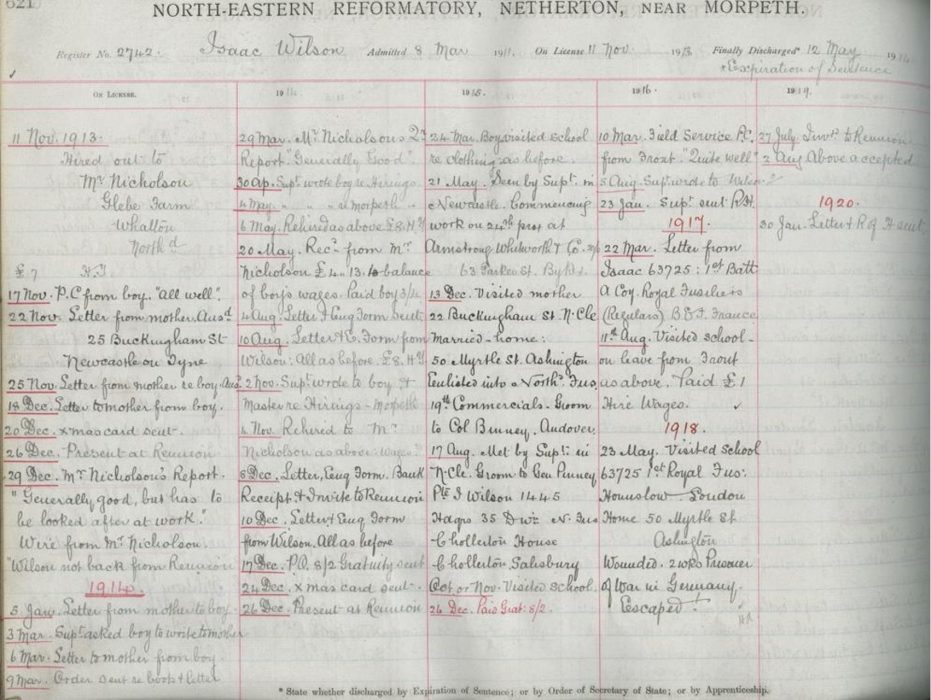Discharge register entry for Isaac Wilson, 1913-19
Reference: NRO/00820/B/25 p. 621
Suggested age groups: KS2, KS3, KS4, lifelong learners
Subject areas: History, Literacy, Geography
CONTEXT
At the beginning of the nineteenth century a child who committed a crime was tried in the same court as an adult. If the judge or magistrate sentenced them to prison, they would be sent to the same prison as adult criminals.
Some campaigners, such as Mary Carpenter, argued that children should be kept away from adult criminals so that they did not learn bad habits from them. She also said that children should be given training and be allowed to play.
Pressure from campaigners led to Parliament passing the Reformatory Schools Act in 1854. The Act allowed reformatory schools to be set up and for them to be officially inspected. Magistrates could send children under the age of 16 to these schools, instead of to prison.
A reformatory school was set up in Newcastle in 1853, just before the Act passed through Parliament. The school was moved to Netherton, near Morpeth, in 1857. In 1933 Netherton became an “Approved School”, which replaced reformatories and industrial schools. Netherton continued to be a residential school for boys well into the 1980s.
When he entered Netherton, Isaac was sentenced to stay at the school until he was 19 years old, like most of the boys that were sent to the school.
When a boy left the school, the staff of the school kept in touch with them for a period of 3–4 years afterwards. The staff recorded their contact with Isaac in the pages that you can see here. We often think of reformatories as harsh places, but it is interesting to note that Isaac wrote to the staff at Netherton and even visited the school once he left. This was not unusual.
In 1913 Isaac left the school to work at the farm of Mr Nicholson; a job that the school found for him. On 21 May 1915 he started work at Armstrong Whitworth Company in Byker, probably to make munitions.
He then joined the Northumberland Fusiliers in December 1915. He seems to have been in France in March 1916 when he sent the school a postcard (PC). He visited the school while on leave from the army. His entry for 1918 records that he was a prisoner of war for two weeks, but that he escaped.
ACTIVITIES
ACTIVITY 1
Background
When a boy left the school, the staff of the school kept in touch with them for a period of 3–4 years afterwards. The staff recorded their contact with Isaac in the pages that you can see here. We often think of reformatories as harsh places, but it is interesting to note that Isaac wrote to the staff at Netherton once he left. This was not unusual.
SEE
See: How old was Isaac when he left Netherton?
See: Where did Isaac go when he left Netherton?
See: What major world event was about to begin when Isaac left Netherton?
See: How long did the school keep in touch with Isaac after he left?
See: Did Isaac continue to commit crimes after he left the school?
See: What work did Isaac undertake after his time at Netherton?
THINK
Think: Why did reformatories keep in touch with the boys after they left the school?
Think: What can you learn about Isaac’s attitude towards the school from the discharge register?
Think: What can we learn about the effectiveness of reformatory schools from discharge registers?
Think: What was the purpose of sending child criminals to reformatory school?
Think: Was this purpose achieved with Isaac Wilson?
DO
Do: Imagine you are Isaac. Write a series of letters to the reformatory to update them on your life between 1913 and 1919.
Do: Research some of the other boys from Netherton, along with other reformatory schools. Create a presentation showing how effective reform school was as a form of punishment and rehabilitation.
Do: Create a map showing the different places that Isaac visited after he left Netherton.
Resources
ACTIVITY 2
Background
At the beginning of the nineteenth century a child who committed a crime was tried in the same court as an adult. If the judge or magistrate sentenced them to prison, they would be sent to the same prison as adult criminals. Pressure from campaigners led to Parliament passing the Reformatory Schools Act in 1854. The Act allowed reformatory schools to be set up and for them to be officially inspected. Magistrates could send children under the age of 16 to these schools, instead of to prison.
SEE
See: How were child criminals tried and sentenced in the early nineteenth century?
See: Why did campaigners want to keep child criminals separate from adult criminals?
See: What did Mary Carpenter say children should be given, rather than being sent to prison with adults?
See: When was the Reformatory Schools Act passed?
See: Who could be sent to reformatory school?
THINK
Think: What were Mary Carpenter’s education principles and methods?
Think: How were Mary Carpenter’s education principles and methods different to the general principles of the time?
Think: What was the purpose of reformatory school?
Think: What were the conditions like in reformatory school?
Think: What were the rules and regulations of reformatory school?
Think: What would the children have spent their time doing at reformatory school?
DO
Do: In small groups, debate whether or not introducing reformatory schools was the right way to punish child criminals.
Do: Using the information provided by the Children’s Homes website, draw up a plan of Netherton.
Resources
OTHER ONLINE RESOURCES
The National Archives website, page on “Victorian Children in Trouble”: https://www.nationalarchives.gov.uk/education/resources/victorian-children-in-trouble/
Infed.org website, page about Mary Carpenter and her ideas about education:
https://infed.org/mobi/mary-carpenter-reformatory-schools-and-education/
Northumberland Archives blog, page about Netherton Reformatory:
https://northumberlandarchives.com/test/2015/03/30/netherton-reformatory-one-mans-first-world-war-story-david-eckstein/
Children’s Homes website, page with history of Netherton Reformatory:
http://childrenshomes.org.uk/NethertonRfy/
Children’s Homes website, page with general information about reformatories: http://childrenshomes.org.uk/Rfy/
Children’s Homes website, page with model rules and regulations (1890): http://childrenshomes.org.uk/rules/Rfy.shtml


